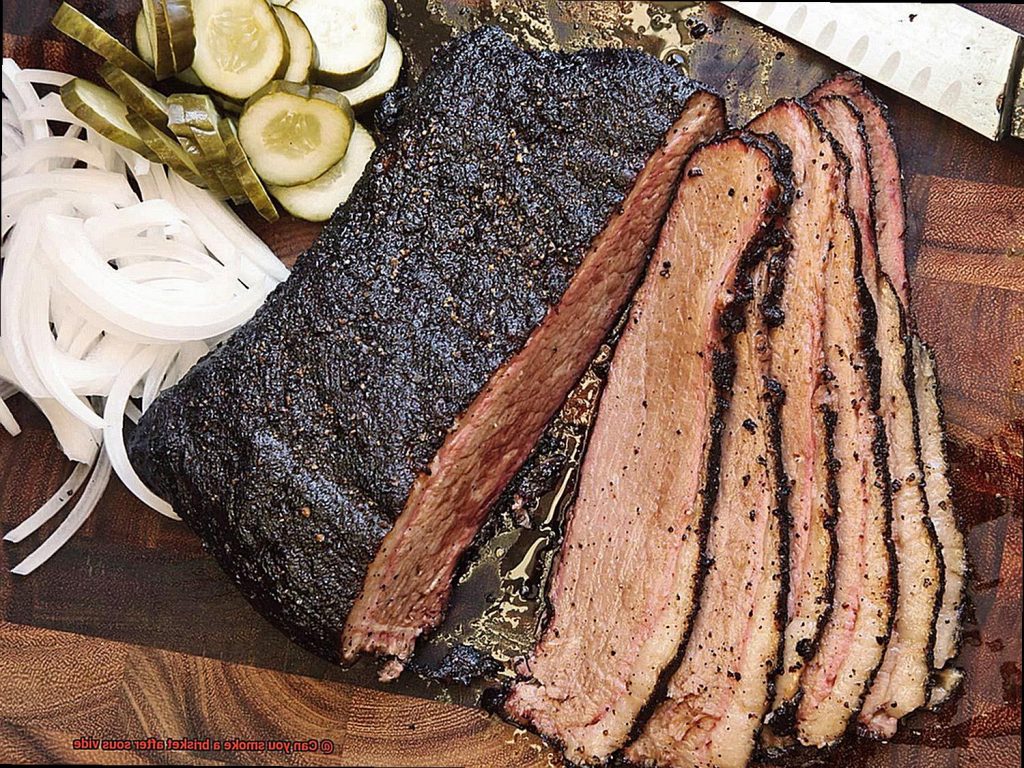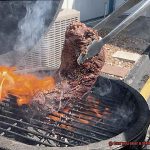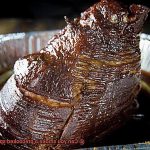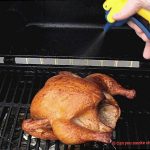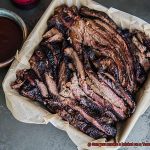If you’ve ever wondered how to take your perfectly tender sous vide brisket and transform it into a smoky, melt-in-your-mouth masterpiece, we’ve got the answer for you. Welcome to the world of smoking brisket after sous vide.
Imagine this: a juicy, mouthwatering brisket, cooked to perfection through hours of precise sous vide cooking. Now picture that same brisket, infused with sweet and smoky flavors after a luxurious session in your favorite smoker. The result? A harmonious blend of tenderness and intense flavor that will leave your taste buds singing praises.
In this blog post, we’ll delve into the process and benefits of smoking a brisket after sous vide. We’ll explain how this method combines the precision of sous vide cooking with the unmistakable taste that only smoking can deliver. So grab your apron, fire up your smoker, and get ready for an incredible culinary adventure. Your BBQ game is about to reach new heights.
Contents
What is Sous Vide?
Sous vide is a French cooking technique that involves vacuum-sealing food and cooking it in a precisely controlled water bath. While sous vide alone can produce incredibly tender and flavorful dishes, you might be wondering if it’s possible to achieve that smoky goodness that grilling offers.
Well, the answer is yes. In this article, we’ll explore how you can combine the power of sous vide with the delicious smokiness of grilling to create the ultimate brisket experience.
The Sous Vide Advantage:
Sous vide cooking offers precise temperature control and even heat distribution, resulting in perfectly cooked meat every time.
By sealing the brisket in a vacuum-sealed bag and cooking it at a low temperature for an extended period, you ensure that the meat retains its moisture, flavors, and tenderness. However, sous vide alone doesn’t provide that coveted smoky flavor and bark that we associate with traditional smoked brisket.
The Smoking Process:
To achieve that mouthwatering smokiness, you’ll need to finish off your sous vide-cooked brisket on a grill or smoker. After removing the brisket from the vacuum-sealed bag, pat it dry to remove excess moisture. Preheat your smoker to around 225-250°F (107-121°C) and place the brisket on the grates. Use wood chips or chunks like hickory or mesquite for that classic smoky flavor. Smoke the brisket for 4 to 8 hours, monitoring the temperature throughout. You can baste or spritz it with a sauce or juice of your choice to enhance flavor and juiciness.
Tips for Success:
Experiment with different smoking times, temperatures, and wood types to find your perfect flavor profile.
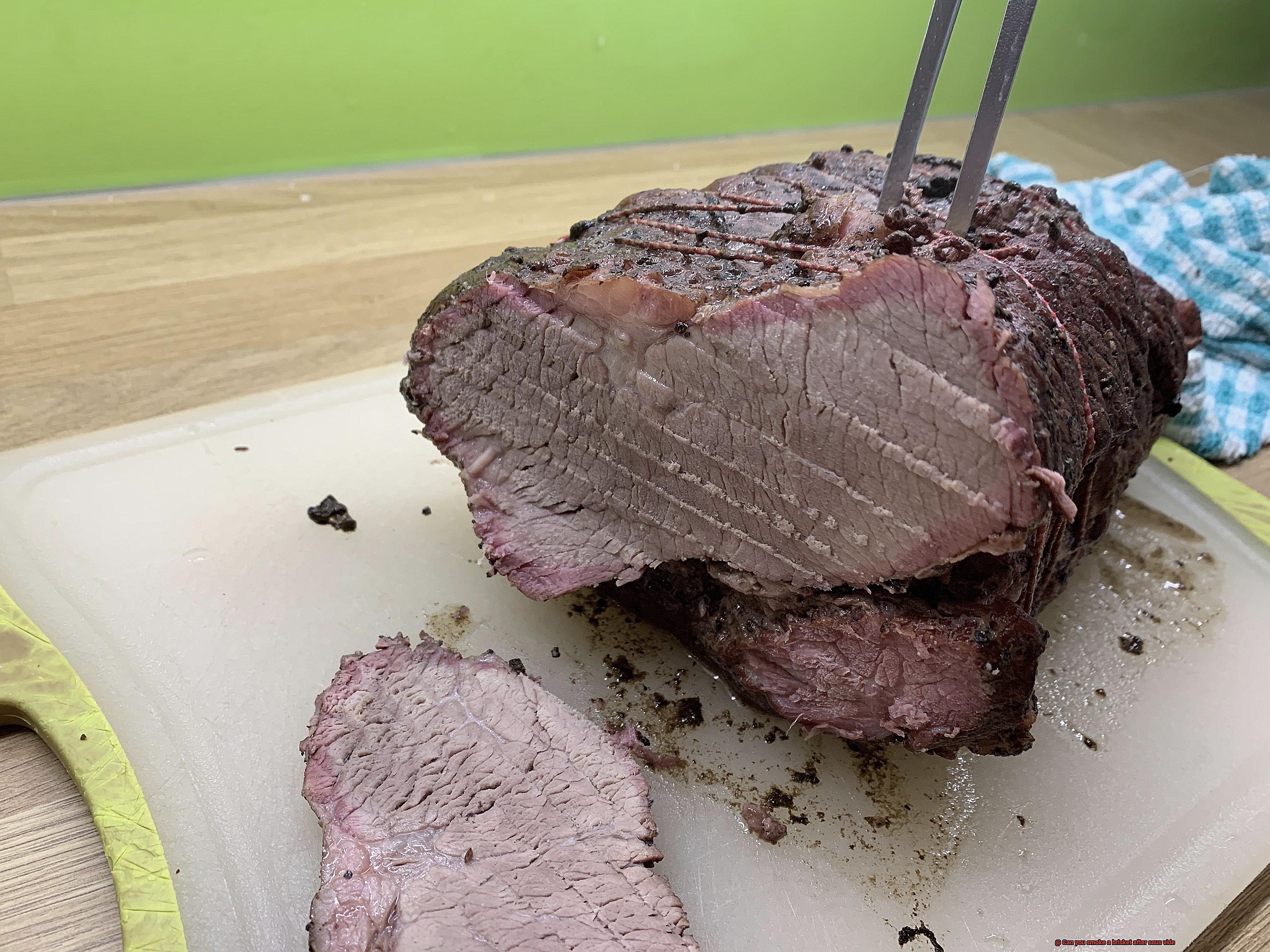
Consider reverse-searing your brisket by smoking it before sous vide for a bark development and tenderness combination.
Ensure the brisket reaches an internal temperature of around 200°F (93°C) for optimal tenderness.
Let the brisket rest before slicing to allow the juices to redistribute for a succulent final product.
Conclusion:
By combining the precision of sous vide cooking with the smoky goodness of grilling, you can elevate your brisket game to new heights. Sous vide ensures tender, moist meat, while smoking adds that irresistible smoky flavor we all love.
So, fire up your grill, embrace the wonders of sous vide, and prepare to impress your friends and family with the most mouthwatering brisket they’ve ever tasted.
Why Smoke a Brisket After Sous Vide?
If you’re a fan of tender, melt-in-your-mouth brisket, then you’ve probably heard of the sous vide cooking method. But if you stop there, you’ll be missing out on one crucial element – the smoky flavor that comes with traditional barbecue. That’s where smoking comes in. Here’s why smoking a brisket after sous vide is beneficial:
- Deep, Smoky Flavor: Sous vide cooking produces perfectly cooked and tender meat, but it lacks the smoky flavor that we all love in traditional barbecue. Smoking the brisket after sous vide allows you to infuse that delicious smokiness into the meat, elevating its taste to new heights.
- Complex Flavors: The low and slow cooking method used in smoking helps develop complex flavors in the brisket. The smoke from the wood chips or chunks penetrates the meat, creating a unique taste that cannot be replicated with any other cooking method. This smoky flavor complements the natural flavors of the meat and adds an extra layer of depth to every bite.
- Beautiful Bark: Smoking a brisket after sous vide helps achieve a beautiful bark on the outside of the meat. The high heat and smoke during the smoking process create a crusty exterior known as the bark. This bark not only adds texture to the brisket but also intensifies the flavors by concentrating them on the surface.
- Authentic Barbecue Experience: Smoking is synonymous with barbecue, and by smoking your brisket, you can recreate that classic barbecue taste at home. The aroma of smoked meat wafting through your backyard can be incredibly enticing and can make your meal feel like a special occasion.
- Customizable Smokiness: Smoking a brisket after sous vide allows you to customize the level of smokiness to your preference. Different types of wood chips or chunks, such as hickory, mesquite, or applewood, impart their own unique flavor profiles. By experimenting with different woods and smoking times, you can find the perfect balance of smokiness that suits your palate.
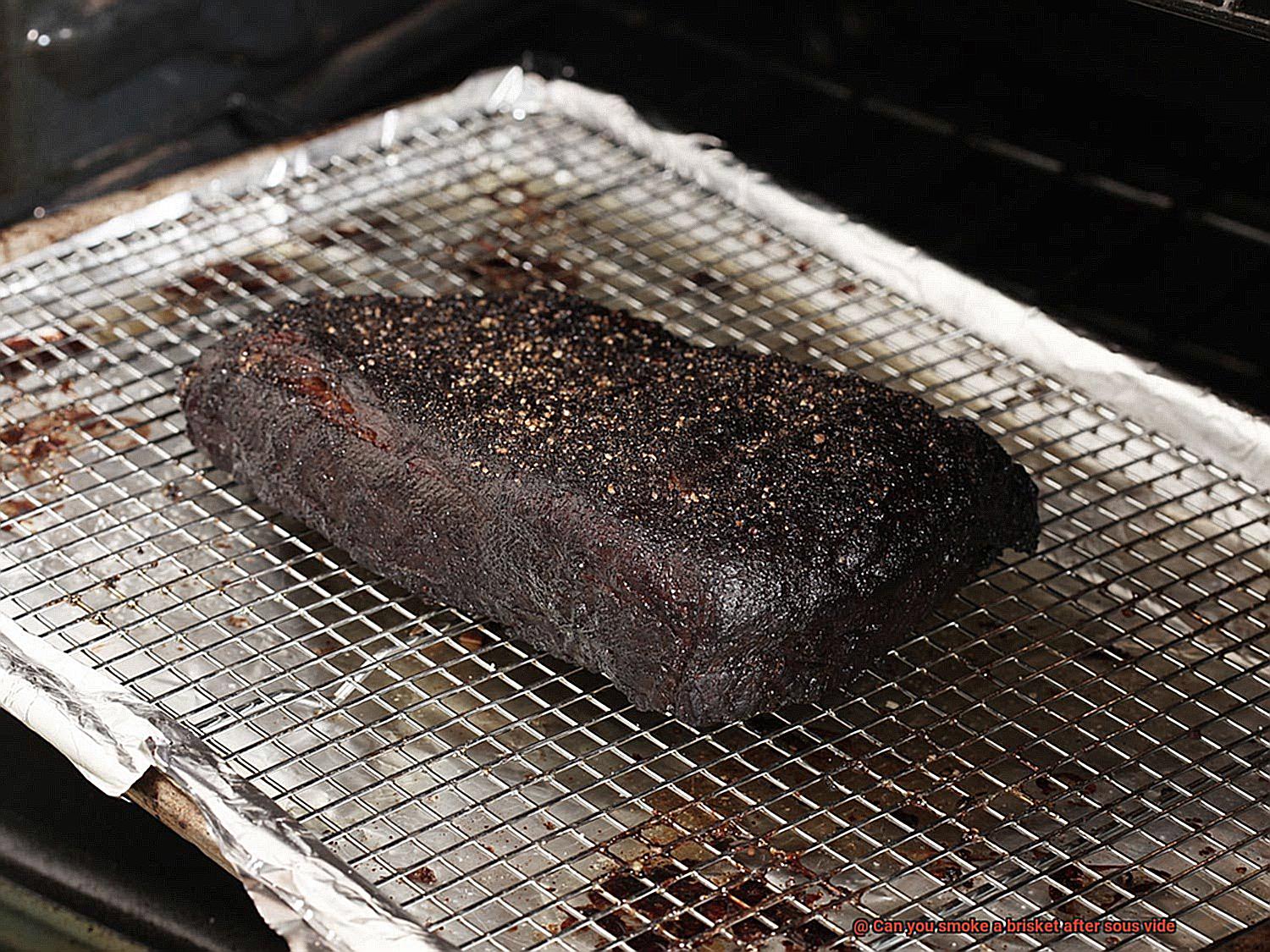
Preparing the Brisket for Smoking
To achieve the perfect smoked brisket after sous vide cooking, there are several crucial steps to prepare the meat for the smoking process. Let’s explore these steps in detail to ensure a mouthwatering and flavorful result.
The first step is to allow the cooked brisket to fully cool down. This can be accomplished by placing the brisket in an ice bath for approximately 30 minutes or until it reaches a safe internal temperature. The ice bath not only chills the meat but also helps it retain its juices during smoking.
Once the brisket is chilled, it is essential to pat it dry with paper towels. This step removes any excess moisture, preventing the meat from steaming and allowing the smoke to penetrate more effectively. A dry surface is also crucial for creating that coveted bark we all love.
Now, let’s talk about seasoning. The key to unlocking a world of flavor lies in a well-balanced rub. For a classic and foolproof rub, combine salt, black pepper, paprika, garlic powder, and onion powder. Generously apply this magical mixture on all sides of your brisket, ensuring every inch is coated with love.
After seasoning, let your brisket rest at room temperature for around 30 minutes. This allows the flavors to mingle and penetrate the meat while helping the surface dry out slightly. This drying process is crucial for developing that beautiful bark we all long for.
While your seasoned brisket is resting, it’s time to set up your smoker and preheat it to a temperature range between 225°F and 250°F (107°C and 121°C). This low and slow cooking method ensures your brisket becomes tender, juicy, and infused with smoky goodness.
When it comes to choosing the right wood for smoking, personal preference plays a significant role. Some pitmasters swear by oak, hickory, or mesquite for their bold flavors. However, feel free to experiment with different types of wood to find your perfect match. Just make sure you have enough wood chips or chunks to maintain a steady stream of smoke throughout the cooking process.
Now that your smoker is preheated and producing that tantalizing smoke, it’s time to place your prepared brisket on the grates. To maximize flavor and tenderness, position the brisket with the fat cap facing up. As it cooks, the rendered fat will baste the meat, infusing it with even more moisture and flavor.
Throughout the smoking process, it’s essential to keep an eye on the internal temperature of your brisket using a reliable meat thermometer. The target temperature for a perfectly smoked brisket is usually around 195°F to 205°F (90°C to 96°C).
However, some pitmasters prefer to remove the brisket from the smoker when it reaches an internal temperature of about 190°F (88°C) and finish it off by wrapping it in foil and letting it rest for an hour or two.
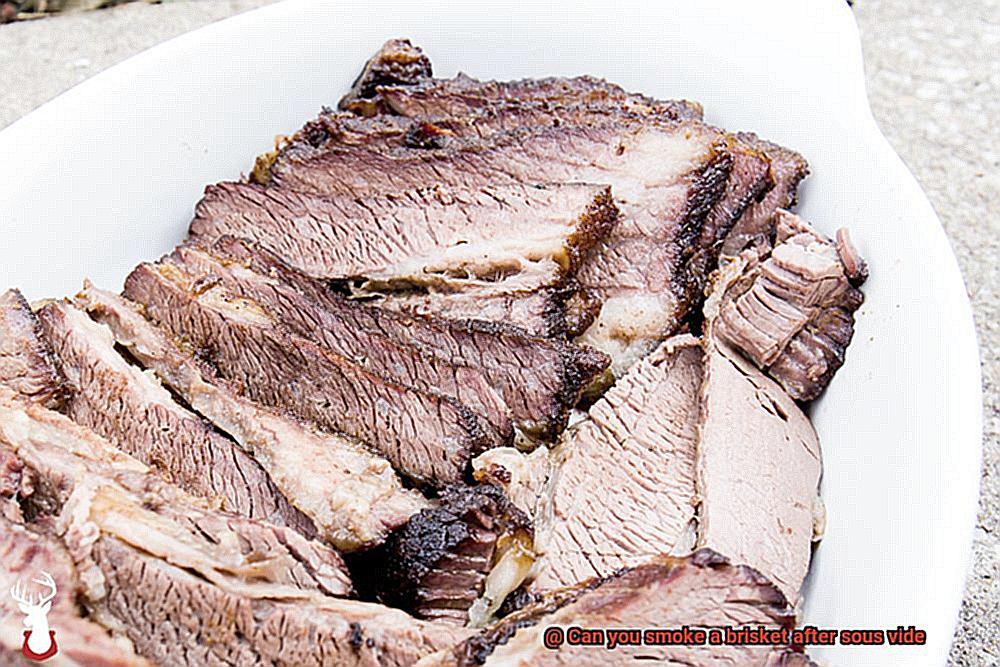
Setting Up the Smoker
You’ve mastered the art of cooking a tender and juicy brisket using the sous vide method. But now, it’s time to take your culinary adventure to new heights by infusing that mouthwatering meat with a rich and smoky flavor. Get ready to set up your smoker and create a symphony of flavors that will leave your taste buds singing.
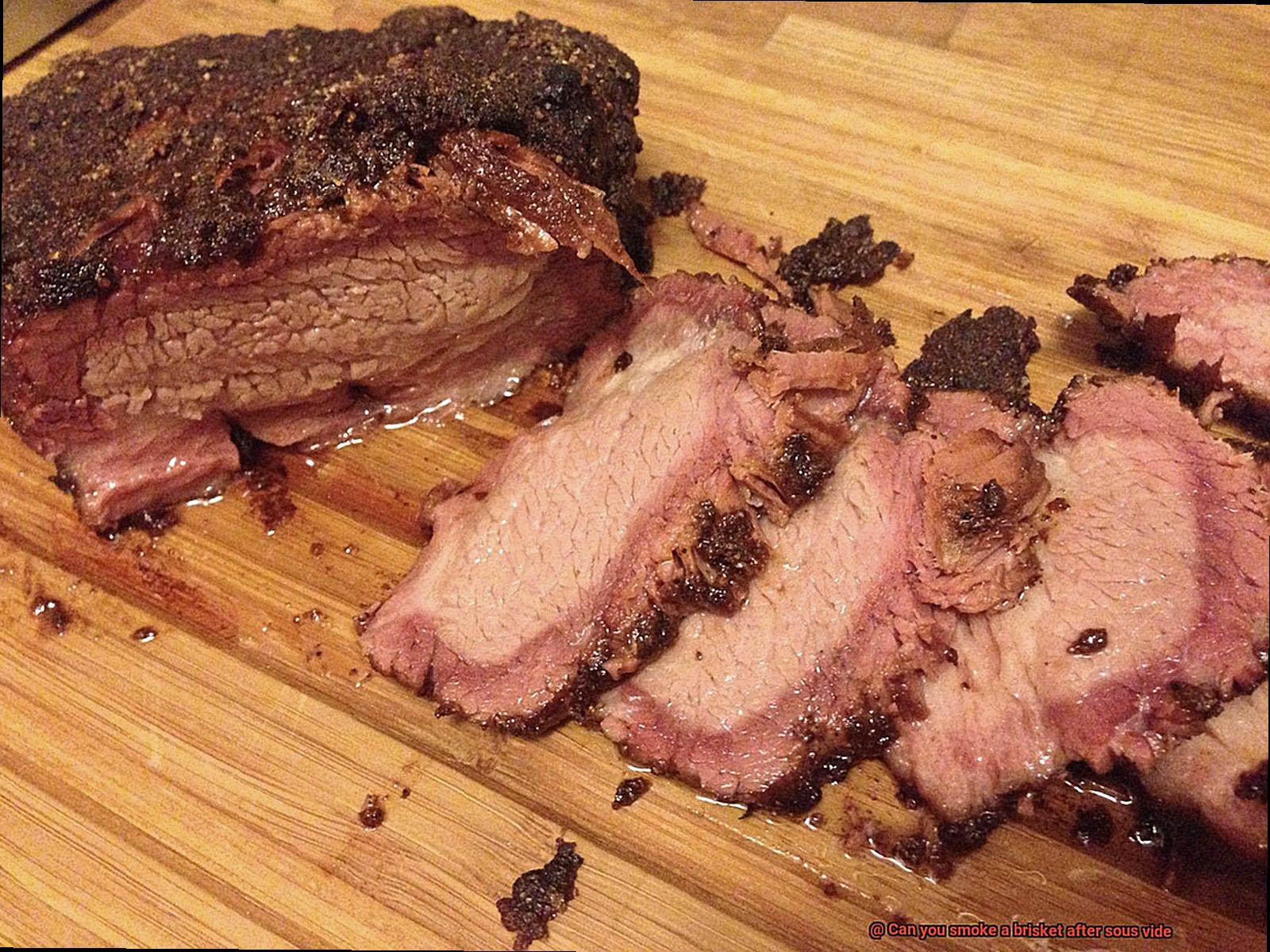
First things first, before diving into the smoking process, ensure that your smoker is clean and in optimal working condition. Remove any lingering ash or debris from previous smoking sessions, and carefully inspect the temperature controls to make sure they’re functioning properly. Safety is paramount, so keep a fire extinguisher handy and follow the manufacturer’s instructions for safe operation.
Now let’s talk wood. The choice of wood chips or chunks is crucial in imparting that distinct smoky aroma to your brisket. For an authentic smoky flavor, opt for hardwoods like hickory, oak, or mesquite. Soak the wood chips in water for about 30 minutes before using them in the smoker. This simple step slows down their burn rate and ensures they release flavorful smoke throughout the cooking process.
Once your smoker is preheated to around 225°F (107°C) – the sweet spot for smoking a brisket – it’s time to dry off your perfectly cooked sous vide brisket. Carefully remove it from its bag and pat it dry with paper towels. This essential step creates an ideal surface for developing a beautiful smoke ring and bark on the outside of the brisket.
Now comes the fun part – seasoning. Whether you prefer a dry rub or a marinade, evenly apply your chosen seasoning to all sides of the brisket. This ensures that every bite is bursting with flavor – a tantalizing blend of herbs, spices, and smokiness.
With the smoker at the desired temperature and the brisket seasoned to perfection, it’s time to introduce the smoky element. Add the soaked wood chips onto the hot coals or place them in a designated wood chip tray for electric smokers. As the chips smolder and release their aromatic smoke, it will penetrate the meat, infusing it with that unmistakable smoky character.
Now, place the seasoned brisket onto the smoker’s cooking grate and close the lid. This is where patience becomes your greatest virtue. Let the magic happen as the brisket slowly smokes for several hours, allowing the flavors to meld and develop. The exact cooking time will depend on the size of your brisket and your desired level of doneness.
To ensure your brisket is cooked to perfection, use a meat thermometer to monitor its internal temperature. Aim for around 195°F (90°C) for that ideal tenderness and succulence.
Smoking the Brisket
Imagine sinking your teeth into a tender and succulent brisket, infused with the irresistible flavors of smoky goodness. Combining the precise cooking technique of sous vide with the traditional art of smoking creates a winning combination that takes your brisket to new levels of flavor and tenderness.
Here, we will guide you through the steps to achieve maximum smoky perfection when smoking your brisket after sous vide.
Step 1: Preparing the Brisket
After removing the brisket from its luxurious sous vide bath, delicately pat it dry with paper towels. This crucial step removes excess moisture, allowing the smoke to adhere better to the meat. A dry surface fosters crust development during smoking, adding an extra layer of texture and flavor.
Step 2: Preheating Your Smoker
Before placing the brisket on the grates, ensure your smoker is preheated to the desired temperature. This guarantees immediate cooking and helps create a beautiful crust on the outside of the meat. Aim for a consistent temperature between 225°F and 250°F, following the low and slow method that guarantees tender and flavorful results.
Step 3: Choosing the Right Wood
Selecting the right wood is essential for infusing your brisket with tantalizing smoky flavors. Opt for hardwood chips or chunks, such as hickory, oak, mesquite, or cherry wood. Soak your wood chips in water for about 30 minutes before placing them in the smoker box or directly on the coals. This ensures a slow release of smoke throughout the cooking process, enveloping your brisket in layers of delicious aroma.
Step 4: Smoking the Brisket
With your brisket positioned on the smoker grates, fat side up, close the lid and let the magic unfold. The smoke dances around your meat, transforming it into a mouthwatering masterpiece. Maintain a consistent temperature throughout the smoking process and periodically baste or spritz the brisket with a mop sauce, apple juice, or vinegar. This ensures the meat remains moist and adds an extra layer of flavor.
Step 5: Monitoring the Internal Temperature
To achieve optimal tenderness, it is crucial to monitor the internal temperature of your brisket. Utilize a reliable meat thermometer to ensure it reaches at least 203°F. The slow cooking process can take anywhere from 8 to 16 hours, depending on the size and thickness of your brisket. Patience is key here, as the result is a melt-in-your-mouth tenderness that is worth every minute.
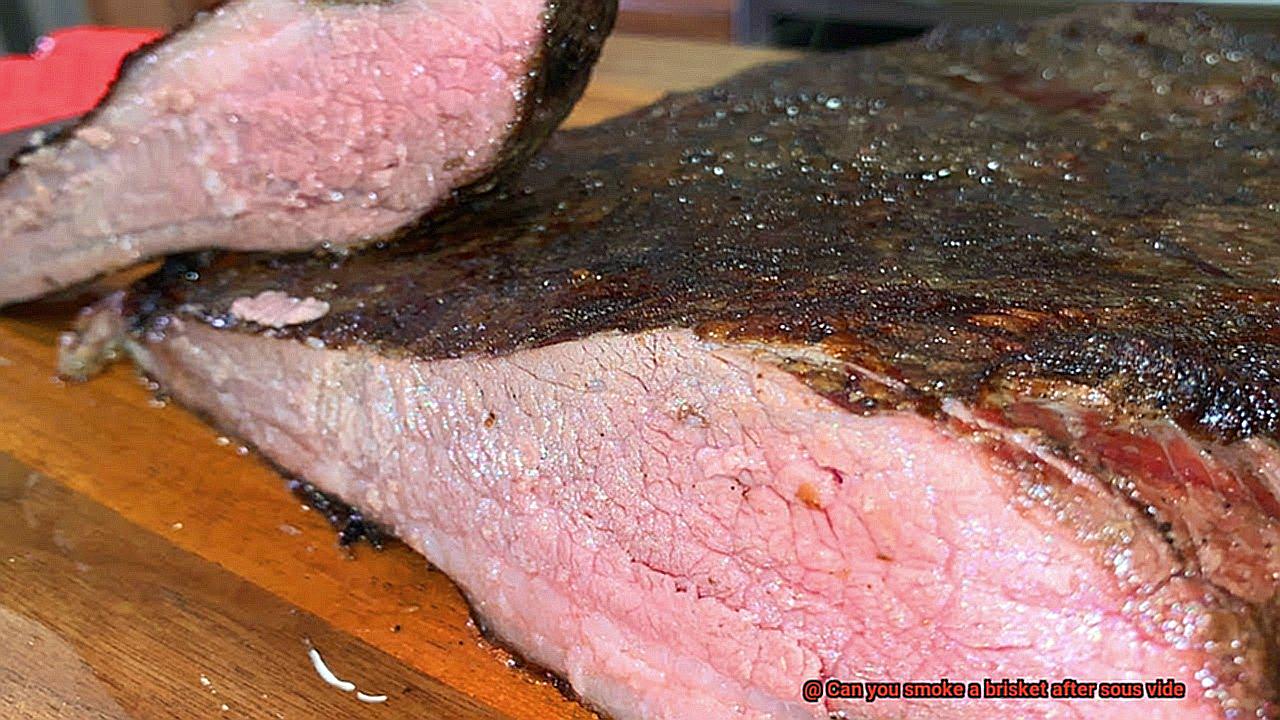
Basting and Spritzing the Brisket
We’ll dive into the importance of basting and spritzing your brisket after sous vide cooking to achieve that irresistible smoky flavor and perfect tenderness.
Basting: Keeping the Moisture and Flavor Locked In
Basting is a vital technique that helps maintain moisture levels and prevents the meat from drying out during the smoking process. To baste your brisket, use a brush or mop to evenly coat the surface with a marinade or barbecue sauce. This not only keeps the meat juicy but also infuses it with additional flavors, adding depth and complexity to your final dish. Remember to baste regularly, every 30 minutes to an hour, ensuring that every inch of your brisket is covered.
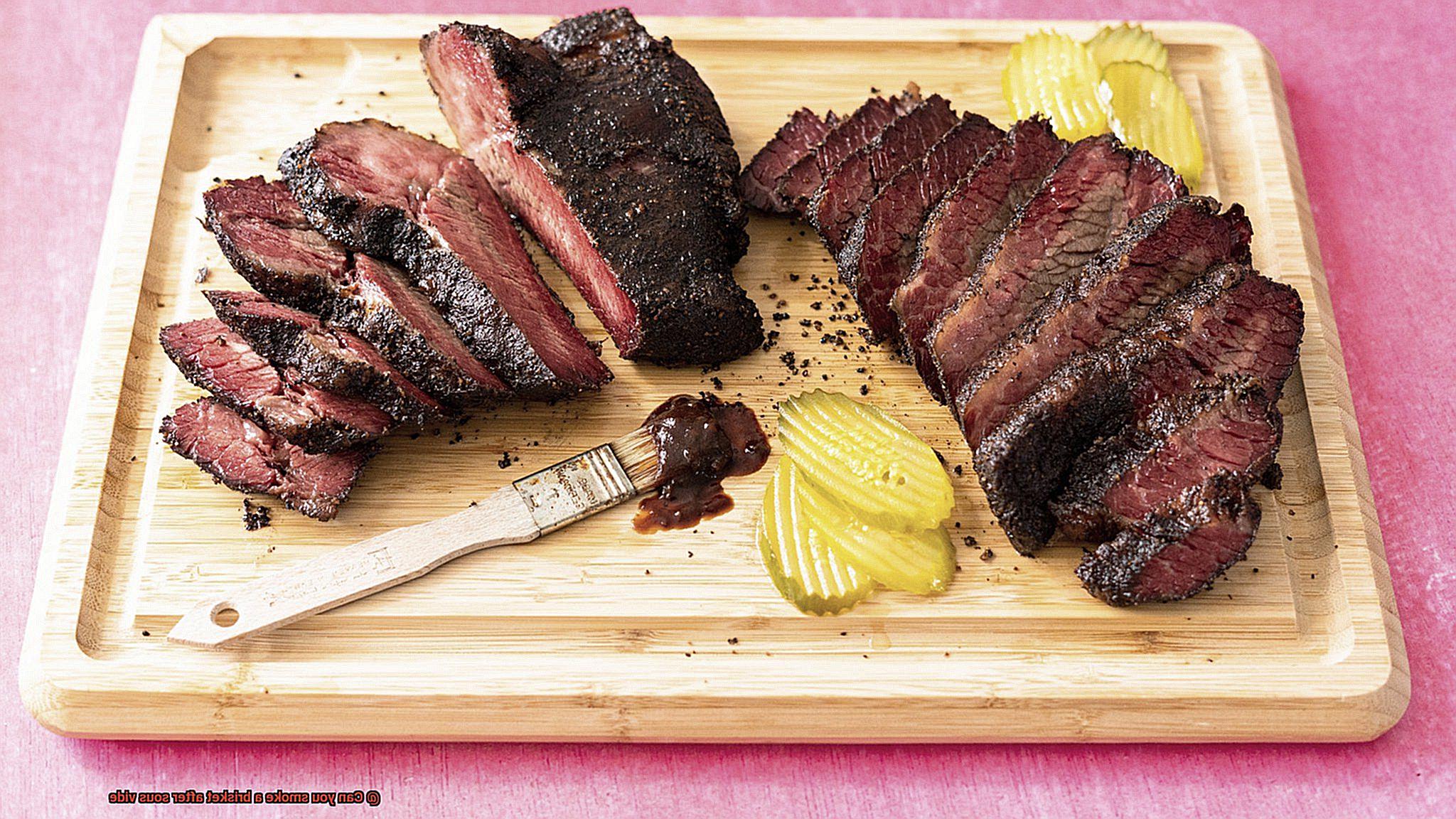
Spritzing: Adding Tang and Moisture
Spritzing is another technique that adds both moisture and tangy flavor to your brisket. Lightly mist your brisket with apple cider vinegar or a vinegar-water mixture using a spray bottle or spritzer. This method helps keep the meat moist while complementing the smokiness with a delightful tang. Similar to basting, spritz regularly throughout the smoking process for maximum impact.
Proper Execution: Enhancing, Not Overpowering
When incorporating these techniques after sous vide cooking, it’s essential to execute them properly. Allow your brisket to cool down after sous vide cooking before applying any liquids to prevent food safety risks. Since sous vide already provides a tender and juicy result, use basting and spritzing techniques sparingly. Apply the liquid mixture lightly, enhancing the existing flavors without overwhelming them. Avoid saturating the brisket, as it can affect texture and turn it mushy.
Efficiency Matters: Minimize Heat Loss
Keep in mind that each time you open the smoker to baste or spritz, heat and smoke can escape. To minimize heat loss, work quickly and efficiently during the process. This will ensure that your brisket receives the necessary flavors without compromising the cooking process.
Checking for Doneness
When it comes to cooking a brisket sous vide, checking for doneness is a crucial step before smoking it. While sous vide cooking ensures precise internal temperatures, it may not give you the desired texture and flavor that come from traditional smoking. So, let’s dive into the steps you need to follow to ensure your brisket is perfectly cooked and ready for that smoky goodness.
There are two main methods to check for doneness: using a meat thermometer and relying on touch. First, let’s talk about using a meat thermometer. Simply insert the probe into the thickest part of the brisket and make sure it reaches the desired internal temperature. For a melt-in-your-mouth medium-rare brisket, aim for an internal temperature of around 135°F (57°C). If you prefer your brisket more towards medium or medium-well, then look for an internal temperature between 145°F to 155°F (63°C to 68°C).
In addition to using a meat thermometer, you can also rely on the sense of touch to determine doneness. A properly cooked brisket should feel tender when pressed with your fingers. If it still feels firm or tough, then it may need more time in the sous vide bath. Remember, sous vide cooking takes its time to break down tough fibers and render fat, so a little extra patience can go a long way.
Now, let’s talk about time and temperature. The longer you cook the brisket sous vide, the more tender it will become. However, be cautious not to overcook it as it can turn mushy and lose its delightful texture. So, find that sweet spot where tenderness meets flavor.
Once you have determined that your brisket is cooked to perfection, it’s time to move on to the smoking process. But before you fire up that smoker, make sure to pat dry the surface of the brisket with paper towels. This simple step removes any excess moisture, allowing for better smoke absorption and enhancing the overall flavor profile.
When smoking your sous vide cooked brisket, opt for indirect heat and low temperatures. This method allows the smoky goodness to infuse into the meat without overcooking it. Keep an eye on the internal temperature while smoking to ensure you reach your desired level of doneness without drying out the brisket.
After the smoking process, it’s important to let your brisket rest for a few minutes before slicing. This resting period allows the juices to redistribute, resulting in a more flavorful and tender final product. So, exercise a little patience and let that beautiful piece of meat work its magic.
Resting the Brisket Before Slicing
Before you start slicing, there’s an important step you shouldn’t overlook: resting the brisket.
Resting the brisket after cooking is like giving it a well-deserved spa day. It allows the meat to relax and reabsorb its juices, resulting in an even more succulent and delicious final product. Just imagine each slice bursting with flavor and practically melting in your mouth.
During the sous vide cooking process, your brisket undergoes a slow and steady transformation. The low temperature and extended cooking time break down tough connective tissues, turning them into gelatin that infuses the meat with flavor and moisture. But here’s the catch: all those delicious juices are distributed throughout the cut.
That’s where resting comes into play. By giving the brisket time to rest, you’re allowing it to reabsorb those precious juices. This is what takes your brisket from good to extraordinary. Each slice becomes a tender, juicy masterpiece that will have your taste buds singing with delight.
Now, how long should you let it rest? That depends on the size and thickness of your brisket. As a general rule of thumb, give it at least 30 minutes of undisturbed rest time. If you really want to elevate the flavors, let it chill for an hour or even longer if you can resist the temptation.
But here’s a pro tip: keep that brisket covered with foil or in a warm place during its resting period. This helps retain its heat and ensures that every bite is as juicy as can be.
“Why go through all this trouble?” you may ask. Well, here’s the deal: resting allows the internal temperature of the meat to even out. If you were to slice into it too soon, residual heat could continue cooking the brisket and potentially dry it out. We definitely don’t want that to happen, do we?
So, my fellow grill masters, remember this golden rule: be patient. Let your brisket rest and reabsorb those divine juices before you start slicing. Trust me, the extra time is well worth it when you take that first bite and experience the tender, flavorful delight that only a properly rested brisket can deliver.
AohVgovKI4A” >
Conclusion
Yes, you can absolutely smoke a brisket after sous vide.
The combination of these two cooking methods creates a mouthwatering symphony of flavors that will leave your taste buds dancing with joy. By first sous viding the brisket, you ensure that it is perfectly cooked and tender throughout.
Then, when you take it to the smoker, it adds that irresistible smoky aroma and charred crust that barbecue aficionados crave. It’s like taking your brisket on a flavor adventure, starting with a gentle sous vide bath and ending with a bold and robust smoke session.
So, go ahead, embrace the best of both worlds and elevate your brisket game to new heights by smoking it after sous vide.

